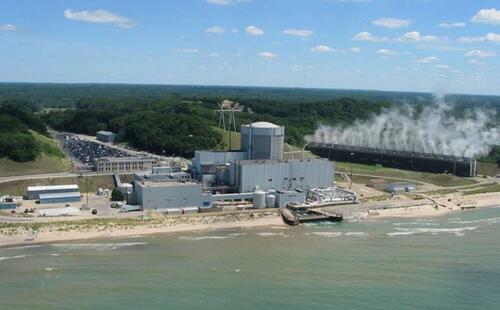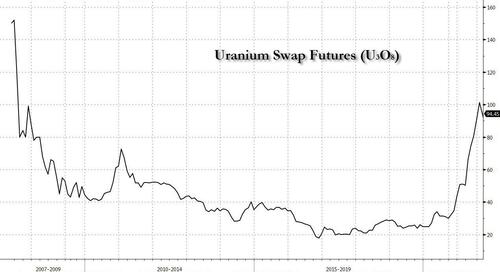
Is the long awaited - and overdue - restart of the American nuclear age finally here?
In a move which may force the lunatic greens to storm the White House, on Wednesday the federal government announced that it would provide a $1.5 billion loan to restart a nuclear power plant in southwestern Michigan. NJ-based Holtec International acquired the 800-megawatt Palisades plant in 2022 with plans to dismantle it, but with support from the state of Michigan and the Biden administration, the emphasis has shifted to restarting the nuclear power plant by late 2025 instead.
What is remarkable is not that the US is throwing some money at a nuclear power plant - since the US sells $1 trillion in debt every 100 days, it may as well go full "Brewster's Millions" (or rather "Trillions") and spend it all asap; it is that this would be the first nuclear power plant to be reopened in the US, setting a precedent as atomic energy makes a triumphal comeback. Sure, it still faces hurdles, including inspections, testing and the blessing of the U.S. Nuclear Regulatory Commission, but those are just formalities: watch as new NPPs start springing up across the country next.
“Nuclear power is our single largest source of carbon-free electricity, directly supporting 100,000 jobs across the country and hundreds of thousands more indirectly,” said Energy Secretary Jennifer Granholm, a former Michigan governor, who in turn is repeating what nuclear advocates have been saying for decades. Restarting this particular plant will protect 600 union jobs and 1,100 throughout the community.
The Palisades plant is along Lake Michigan, a two-hour drive from Chicago. A Michigan utility, CMS Energy, owned it from 1971 until the plant was sold to Louisiana-based utility Entergy in 2007. It was shut down in 2022.
Holtec said it has long-term commitments so far from two electric cooperatives to buy power from the plant.
“The repowering of Palisades will restore safe, around-the-clock generation to hundreds of thousands of households, businesses and manufacturers,” said Kris Singh, Holtec president and chief executive.
Critics, of course, have emerged. A coalition of "greens" opposed to restarting what it derisively calls a “zombie reactor” has requested a hearing at the NRC.
Holtec spokesman Patrick O’Brien said it will take four to five months to finalize the financial deal with the government.
“It is a loan we have to pay back,” he said, explaining that unlike US taxpayer funds embezzled by Ukraine's corrupt leaders and the US Military-Industrial Complex, this particular loan will be tracked and eventually repaid.
Nuclear energy is in the spotlight. Thirty-four countries, including the U.S., last week pledged to use it to reduce reliance on fossil fuels. In California, regulators in December said the Diablo Canyon plant could operate through 2030 instead of 2025 to guard against blackouts as the state shifts toward renewable power sources. Owner Pacific Gas & Electric said federal aid helped it repay a state loan.
“There is more enthusiasm toward nuclear power — in Congress, in the industry and also internationally,” said Najmedin Meshkati, an engineering professor at the University of Southern California who has inspected nuclear plants around the world.
There is another reason why nuclear energy is suddenly back in vogue: with projections for electricity demand over the next five years doubling from just a year ago - due to a building frenzy of AI data centers, federally subsidized manufacturing plants, and the government-driven electric-vehicle transition - the US has no choice but to go full-on nuclear, despite the howls of outrage from green activists and progressive voters.
Still, restarting a plant is not easy.
“It puts the onus and burden on the Nuclear Regulatory Commission and Holtec to double down on efforts to make sure this plant is safe enough and all the safety measures are intact,” Meshkati said of Palisades.
Meanwhile, keep an eye on uranium stocks and more importantly, on the price of uranium itself: as the nuclear renaissance begins in earnest, the world will need lots of uranium, and the supply chains will need years to catch up to demand, which means that what has already been one of the best performing commodities in recent years is set to rise that much higher.
Is the long awaited – and overdue – restart of the American nuclear age finally here?
In a move which may force the lunatic greens to storm the White House, on Wednesday the federal government announced that it would provide a $1.5 billion loan to restart a nuclear power plant in southwestern Michigan. NJ-based Holtec International acquired the 800-megawatt Palisades plant in 2022 with plans to dismantle it, but with support from the state of Michigan and the Biden administration, the emphasis has shifted to restarting the nuclear power plant by late 2025 instead.
What is remarkable is not that the US is throwing some money at a nuclear power plant – since the US sells $1 trillion in debt every 100 days, it may as well go full “Brewster’s Millions” (or rather “Trillions”) and spend it all asap; it is that this would be the first nuclear power plant to be reopened in the US, setting a precedent as atomic energy makes a triumphal comeback. Sure, it still faces hurdles, including inspections, testing and the blessing of the U.S. Nuclear Regulatory Commission, but those are just formalities: watch as new NPPs start springing up across the country next.
“Nuclear power is our single largest source of carbon-free electricity, directly supporting 100,000 jobs across the country and hundreds of thousands more indirectly,” said Energy Secretary Jennifer Granholm, a former Michigan governor, who in turn is repeating what nuclear advocates have been saying for decades. Restarting this particular plant will protect 600 union jobs and 1,100 throughout the community.
The Palisades plant is along Lake Michigan, a two-hour drive from Chicago. A Michigan utility, CMS Energy, owned it from 1971 until the plant was sold to Louisiana-based utility Entergy in 2007. It was shut down in 2022.
Holtec said it has long-term commitments so far from two electric cooperatives to buy power from the plant.
“The repowering of Palisades will restore safe, around-the-clock generation to hundreds of thousands of households, businesses and manufacturers,” said Kris Singh, Holtec president and chief executive.
Critics, of course, have emerged. A coalition of “greens” opposed to restarting what it derisively calls a “zombie reactor” has requested a hearing at the NRC.
Holtec spokesman Patrick O’Brien said it will take four to five months to finalize the financial deal with the government.
“It is a loan we have to pay back,” he said, explaining that unlike US taxpayer funds embezzled by Ukraine’s corrupt leaders and the US Military-Industrial Complex, this particular loan will be tracked and eventually repaid.
Nuclear energy is in the spotlight. Thirty-four countries, including the U.S., last week pledged to use it to reduce reliance on fossil fuels. In California, regulators in December said the Diablo Canyon plant could operate through 2030 instead of 2025 to guard against blackouts as the state shifts toward renewable power sources. Owner Pacific Gas & Electric said federal aid helped it repay a state loan.
“There is more enthusiasm toward nuclear power — in Congress, in the industry and also internationally,” said Najmedin Meshkati, an engineering professor at the University of Southern California who has inspected nuclear plants around the world.
There is another reason why nuclear energy is suddenly back in vogue: with projections for electricity demand over the next five years doubling from just a year ago – due to a building frenzy of AI data centers, federally subsidized manufacturing plants, and the government-driven electric-vehicle transition – the US has no choice but to go full-on nuclear, despite the howls of outrage from green activists and progressive voters.
Still, restarting a plant is not easy.
“It puts the onus and burden on the Nuclear Regulatory Commission and Holtec to double down on efforts to make sure this plant is safe enough and all the safety measures are intact,” Meshkati said of Palisades.
Meanwhile, keep an eye on uranium stocks and more importantly, on the price of uranium itself: as the nuclear renaissance begins in earnest, the world will need lots of uranium, and the supply chains will need years to catch up to demand, which means that what has already been one of the best performing commodities in recent years is set to rise that much higher.
Loading…






